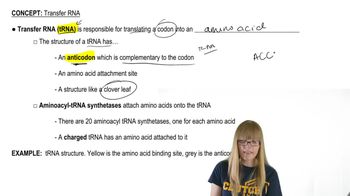With respect to F⁺ and F⁻ bacterial matings, answer the following questions: How was it established that chromosome transfer was unidirectional?
Table of contents
- 1. Introduction to Genetics51m
- 2. Mendel's Laws of Inheritance3h 37m
- 3. Extensions to Mendelian Inheritance2h 41m
- 4. Genetic Mapping and Linkage2h 28m
- 5. Genetics of Bacteria and Viruses1h 21m
- 6. Chromosomal Variation1h 48m
- 7. DNA and Chromosome Structure56m
- 8. DNA Replication1h 10m
- 9. Mitosis and Meiosis1h 34m
- 10. Transcription1h 0m
- 11. Translation58m
- 12. Gene Regulation in Prokaryotes1h 19m
- 13. Gene Regulation in Eukaryotes44m
- 14. Genetic Control of Development44m
- 15. Genomes and Genomics1h 50m
- 16. Transposable Elements47m
- 17. Mutation, Repair, and Recombination1h 6m
- 18. Molecular Genetic Tools19m
- 19. Cancer Genetics29m
- 20. Quantitative Genetics1h 26m
- 21. Population Genetics50m
- 22. Evolutionary Genetics29m
5. Genetics of Bacteria and Viruses
Bacterial Conjugation
Problem 5a
Textbook Question
Explain the importance of the following features in conjugating donor bacteria:
the origin of transfer
 Verified step by step guidance
Verified step by step guidance1
Understand that bacterial conjugation is a process where genetic material is transferred from a donor bacterium to a recipient bacterium through direct contact. The donor bacterium typically contains a plasmid, such as the F plasmid, which facilitates this transfer.
Recognize that the 'origin of transfer' (OriT) is a specific sequence on the plasmid where the transfer process begins. It is crucial because it serves as the starting point for the single-stranded DNA to be cut and transferred to the recipient bacterium.
Learn that the OriT is recognized by proteins encoded by the plasmid, such as relaxase, which initiates the transfer by making a nick at the OriT site. This step is essential for the conjugation machinery to function properly.
Understand that the presence of the OriT ensures that the plasmid DNA is transferred in a controlled and directional manner, allowing the recipient bacterium to receive the genetic material accurately.
Appreciate the importance of the OriT in facilitating horizontal gene transfer, which contributes to genetic diversity and can spread traits such as antibiotic resistance among bacterial populations.
 Verified video answer for a similar problem:
Verified video answer for a similar problem:This video solution was recommended by our tutors as helpful for the problem above
Video duration:
3mPlay a video:
Was this helpful?
Key Concepts
Here are the essential concepts you must grasp in order to answer the question correctly.
Conjugation
Conjugation is a process of horizontal gene transfer in bacteria, where genetic material is transferred from a donor to a recipient cell through direct contact. This mechanism is crucial for the spread of traits such as antibiotic resistance. Understanding conjugation helps in grasping how genetic diversity is generated in bacterial populations.
Recommended video:
Guided course

Conjugation Overview
Origin of Transfer (oriT)
The origin of transfer (oriT) is a specific DNA sequence in the plasmid that initiates the transfer of genetic material during conjugation. It is recognized by the conjugative machinery of the donor bacterium, allowing the plasmid to be replicated and transferred to the recipient. The presence and functionality of oriT are essential for successful gene transfer.
Recommended video:
Plasmids
Plasmids are small, circular DNA molecules that exist independently of chromosomal DNA in bacteria. They often carry genes that confer advantageous traits, such as antibiotic resistance or metabolic capabilities. In the context of conjugation, plasmids with a functional oriT are key players in the transfer process, facilitating the exchange of genetic information between bacteria.
Recommended video:
Guided course

R Plasmid
Related Videos
Related Practice
Textbook Question
475
views



